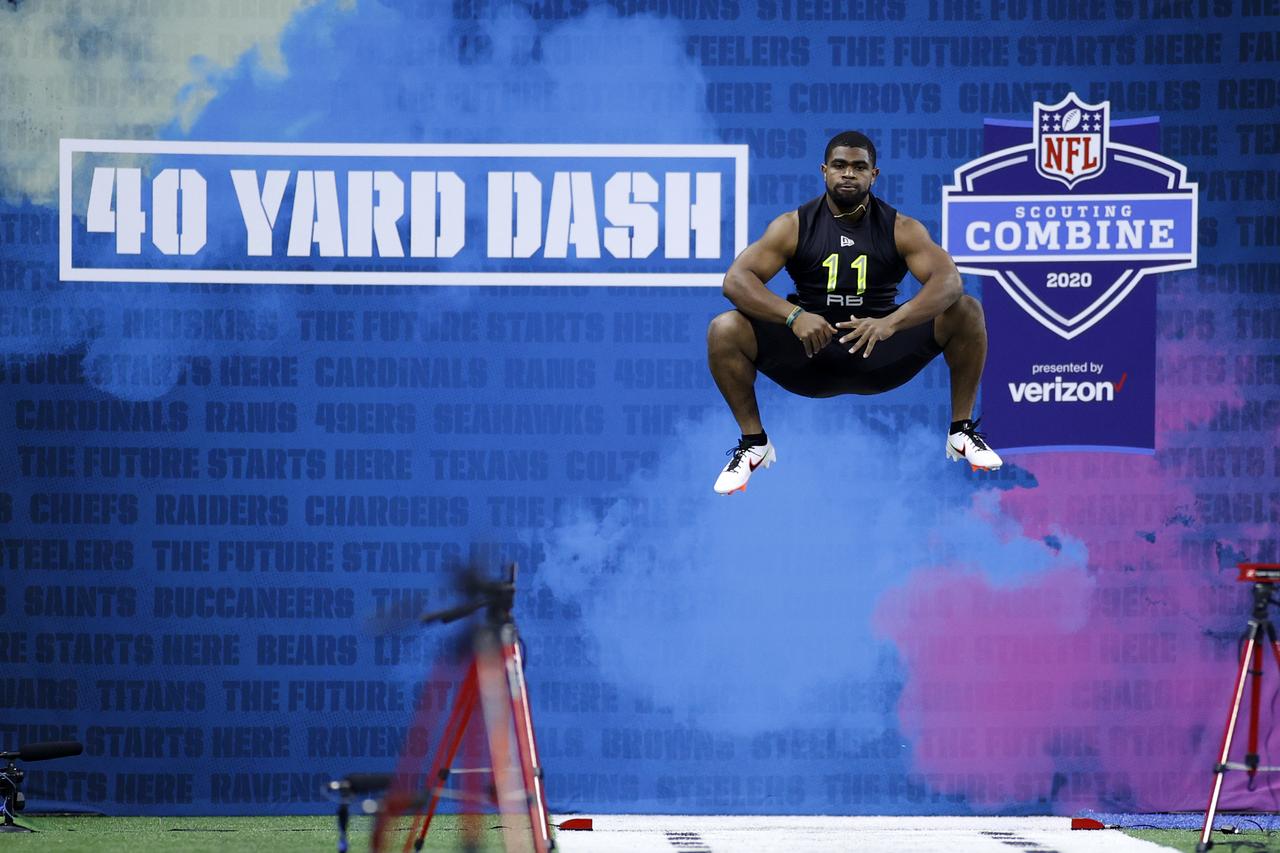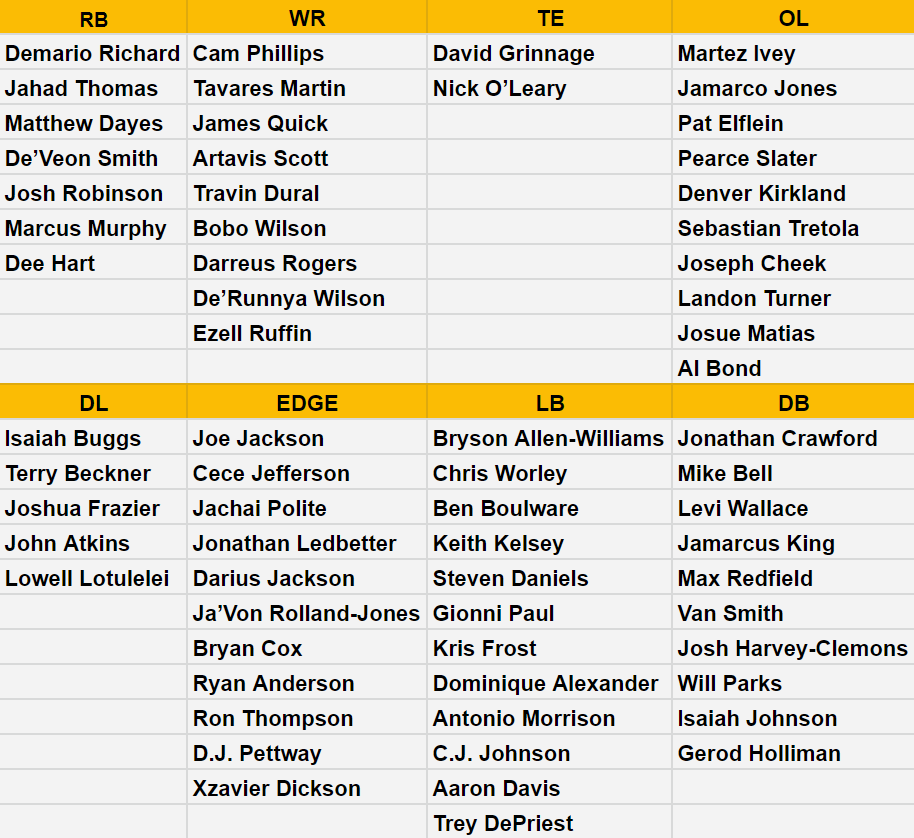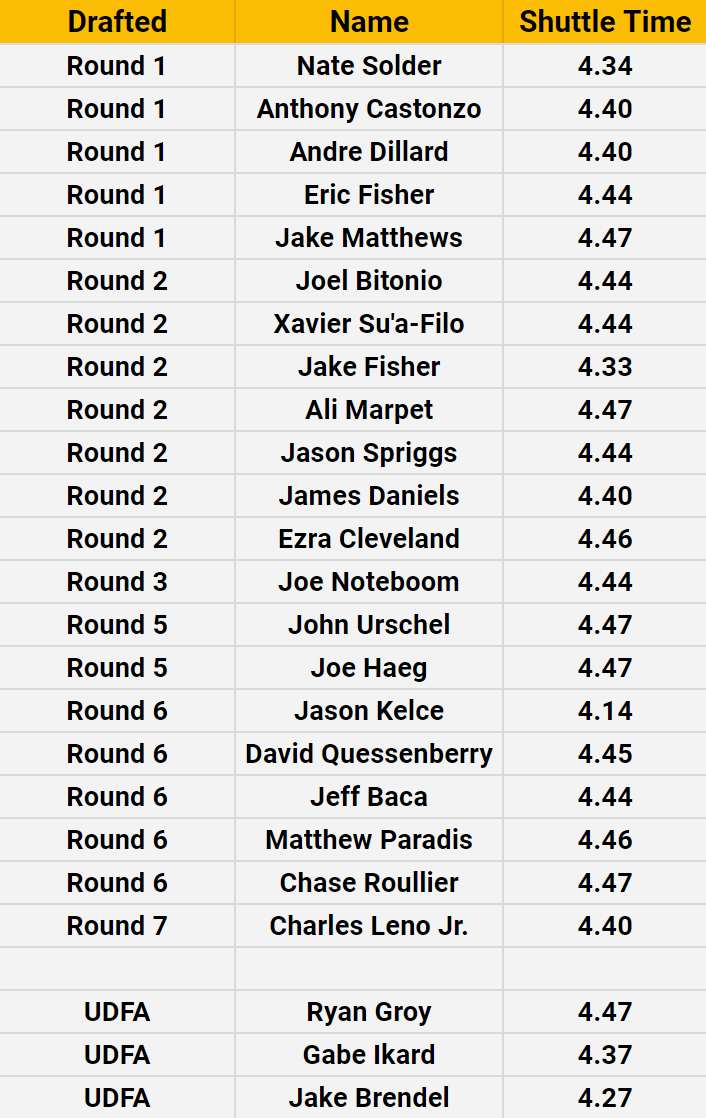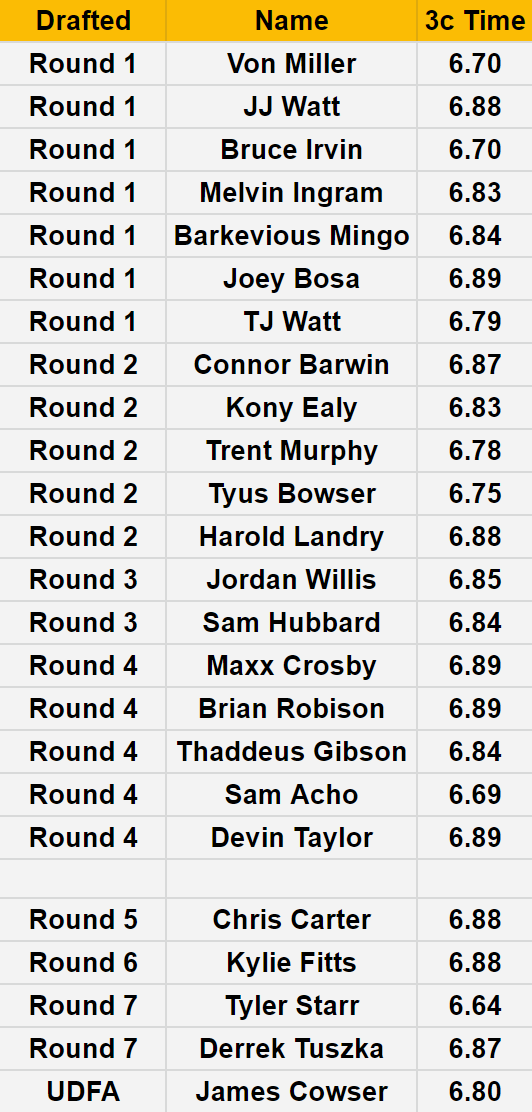2022 NFL Combine: Why It Matters

Now, more than ever, I know NFL Combine results matter. Save your “but the workout warriors!” comments, failed evaluations exist at every layer of the draft process.
My goal here is to teach you what I’ve learned over the past few years, simplified into four parts. To perhaps shift the lens that you watch this week through. And if you aren’t a believer in athletic testing, hopefully your perspective is changed by the end.
As Zach Whitman put it - “Metrics don’t need to be perfect if we do a good job of understanding what they’re saying and what they miss.”
Featured in this post: composite scores, eliminating non-NFL caliber athletes, positions most impacted by athleticism and the individual results that best project success.
COMPOSITE SCORES - A CLEARER PICTURE
More or less, the NFL Combine is broadcast as an event to showcase 40s... followed by position drills. In the past there has not been an extensive focus on other results unless a name or number pops out. Why is the 40 more important than the shuttle? 3-cone? Broad jump? And most of all, our understanding of the results is missing one crucial element - weight. In its simplest terms, a 225-pound RB jump of 38-inches is more impressive than a 205-pound back jumping the same distance. Adjust all results for weight.
What if there was a better way? What if we recognized that the forty is just one of seven or eight or nine meaningful results, and a potentially better way of interpreting athleticism is through a composite score which factors in all outcomes along with weight.
Take Nick Chubb for example. On the surface, a 4.52 forty would not grab anyone’s attention. But when coupled with a 4.25 shuttle, 7.09 3-cone, 38.5-inch vert and over 10.5-foot broad jump at 227 pounds? He tests in the 83rd percentile, meaning he is more athletic than 83 percent of all RBs entering the league.
So what can we do about it? SPARQ is the approachable composite score I use, and Zach Whitman has years and years, thousands and thousands of scores built up in his database so prospects from each Combine can be compared to their predecessors. Great scores obviously stand out, but it is important to note that an average NFL athlete is not a negative. So don’t immediately knock a prospect for testing in the 48th percentile.
I love these composite scores. A single number for total athleticism. I can't tell you what percentage of the evaluation it makes up for me. My brain is not that binary. It likely is a sliding scale for each position and each player. An extraordinary score for a high round pick confirms my confidence in their projection. And towards the end of the process I geek out when pro day numbers come in, completing profiles, in order to work through the top 15 athletes or so at each position in the hopes of finding someone who has slipped through the cracks. These have hit in the past, check the list at the bottom of the column.
Again, let’s stop clinging on to single 40 times when explaining a player’s athleticism. Instead, cite composite scores, which includes all measurements with weight as a factor, as other tests can be equally important.
ELIMINATE BAD ATHLETES
The easiest way to implement athletic testing in evaluations is to eliminate non-NFL caliber athletes. Those so distant from “average” that the hit rate is minuscule. From a composite perspective, this means scores two or more standard deviations away from the mean (-2.0 sigma). To better illustrate this, here are the prospects with non-NFL athleticism since 2015 who also attended the Combine.

How many hits do you see out of 70-ish names? Few. And extending that to all prospects, think of the thousands of Pro Day prospects every season, expands the cut list to hundreds and hundreds each year. Eliminating these players from draft boards entirely is a quick way to minimize the player pool, theoretically improving the rest of your board, even if a very small percentage do “hit” in a five-year span. The best of this is Levi Wallace, an undrafted free agent turned Bills starter. Pat Elflein was a three-year starter for the Vikings and Panthers Free Agent Signing… with very mixed results. Isaiah Buggs started six games for the Steelers in 2021. Ryan Anderson was a failed second-round pick who missed the 2021 season due to PEDs. Abiding by this rule could have prevented the selections of Jachai Polite and Jamarco Jones.
You might ask, “Where is Orlando Brown?” the Chiefs left tackle who produced a woeful workout a few years ago. Thank you for the question, as it leads me to the next point: Pro Day workouts matter! Brown’s testing at Oklahoma thrust him out of non-NFL caliber athlete territory. We all have bad days, players deal with injuries through the draft process and the NFL Combine is a grueling experience. A fusion of fatigue. Therefore allowing players to improve on their testing results in a better environment (pro day) is the correct approach. Prospects know if they bombed an athletic test and know if they can improve. Let’s give them that chance.
WHAT HISTORY TELLS US
These next two sections are singular testing results that best project future success for certain positions. That can be quite a task, finding a single athletic test that has the highest hit rate among the top performers, but two fit the bill. I know career starts might not be the best way to exhibit success, but it does show a combination of trust and longevity teams have in a player.
First is the 20-yard shuttle for offensive linemen.

These are the top Combine testers from 2010 to 2020. In that span, over 300 OL prospects completed a 20-yard shuttle. The top 24 are listed above. As you can see, 21 of the 24 were drafted, and those drafted players went on to start 84% (!!!!) of their career games. Taking it one step further, the eight Day 3 OL started 85% of their career games and includes gems like Jason Kelce, Chase Roullier, Matt Paradis and Charles Leno.
It is not a leap to say that if an offensive lineman at this year’s Combine hits that 4.47 short shuttle, he should be a target player. This type of success is extremely impressive. Again, that result places them in the top percentiles of their position, but it also results in success.
The pass-rushing group is not as clean, but it does show some level of prediction.
Below are the top 3-cone times for EDGE and DL that were drafted in the fourth round or earlier since 2007.

19 prospects hit the Combine 3-cone threshold of 6.89 seconds that went on to be selected in the top four rounds (five others hit that mark but were drafted in rounds 5-7 or were not drafted at all).
The recent emergence of Maxx Crosby, Tyus Bowser, Harold Landry and Sam Hubbard makes this list even better.
Cliff Avril and Clay Matthews just missed with a 6.90. Anthony Barr, who now plays off the ball, registered a 6.82 a few years ago. Again, both of these are only including NFL Combine participants. Obviously all are not “hits,” but the rate of success (of varying degrees based on expectations) in comparison to other positions is high.
Let me reiterate that I am a believer in composite scores. The goal here was to find singular athletic tests that best predict success, and the OL shuttle is undeniable for the top percentile.
SO HOW DO WE USE THIS INFORMATION?
Not to confuse you, but the application of athletic testing is not identical across all positions. Consistently I have seen athletic testing improve my evaluations along the offensive and defensive lines, both for early and late-round picks. Let’s hypothesize why; trench players frequently feature in one of the few one on one matchups on an NFL field. At the basic level, wouldn’t an athletic advantage be a leg up? This extends to day three/UDFA offensive and defensive linemen: prospects who are incomplete but offer an athletic base to develop with coaching.
Outstanding athletic profiles (when matched with intriguing tape) led me directly to Charles Leno, Shaq Mason, Grady Jarrett, David Onyemata, Javon Hargrave, Maxx Crosby and Milton Williams, among round three and later picks. I could list many more.
Conversely, I do not get discouraged when top-ranked running backs do not test like top athletes. In fact, they often test like average to below-average athletes and that’s okay! So much goes into playing the position: vision, balance, aggression just to name a few. It’s great when top backs also test like top athletes: Saquon Barkley and Christian McCaffrey for example, but it isn’t a necessity. I have found that throwing darts on undrafted uber-athletic ball carriers is highly fruitful. Recent examples include Matt Breida, Mike Boone and Raheem Mostert, all testing above the 90th percentile. Even Kene Nwangwu produced a freakish profile, and the Vikings prioritized him despite very little college opportunity.